Generation of a Design Flood-Event Scenario for a Mountain River with Intense Sediment Transport
Abstract
:1. Introduction
2. The Valmalenco Catchments and the Mallero River
2.1. The Hydro-Graphic Basin
2.2. The River
2.3. Past Events
3. Design Flood Scenario Modeling
4. Hydro-Morphologic Analysis for Flows in the Yearly Duration Curve
5. Hydro-Morphologic Analysis for Peak Flow
5.1. Model Parameterization/Validation
5.2. Design Flood Event
6. Concluding Remarks
Acknowledgments
Author Contributions
Conflicts of Interest
References
- Sear, D.A.; Newson, M.D.; Brookes, A. Sediment-related river maintenance: The role of fluvial geomorphology. Earth Surf. Process. Landf. 1995, 20, 629–647. [Google Scholar] [CrossRef]
- Stover, S.C.; Montgomery, D.R. Channel change and flooding, Skokomish River, Washington. J. Hydrol. 2001, 243, 272–286. [Google Scholar] [CrossRef]
- Lane, S.N.; Tayefi, V.; Reid, S.C.; Yu, D.; Hardy, R.J. Interactions between sediment delivery, channel change, climate change and flood risk in a temperate upland environment. Earth Surf. Process. Landf. 2007, 32, 429–446. [Google Scholar] [CrossRef]
- Jaeggi, M. Some aspects of the sediment transport during the 2005 floods in Switzerland. Ann. Wars. Univ. Life Sci. SGGW Land Reclam. 2008, 39, 33–48. [Google Scholar] [CrossRef]
- Rickenmann, D.; Koschni, A. Sediment loads due to fluvial transport and debris flows during the 2005 flood events in Switzerland. Hydrol. Process. 2010, 24, 993–1007. [Google Scholar] [CrossRef]
- Directive 2007/60/EC of the European Parliament and of the Council of 23 October 2007 on the Assessment and Management of Flood Risks. Available online: http://ec.europa.eu/environment/water/flood_risk/ (accessed on 15 December 2016).
- Papanicolaou, A.N.; Bdour, A.; Wicklein, E. One-dimensional hydrodynamic/sediment transport model applicable to steep mountain streams. J. Hydraul. Res. 2004, 42, 357–375. [Google Scholar] [CrossRef]
- Chiari, M.; Friedl, K.; Rickenmann, D. A one-dimensional bedload transport model for steep slopes. J. Hydraul. Res. 2010, 48, 152–160. [Google Scholar] [CrossRef]
- Rosatti, G.; Bonaventura, L.; Deponti, A.; Garegnani, G. An accurate and efficient semi-implicit method for section-averaged free-surface flow modeling. Int. J. Numer. Metheds Fluids 2011, 65, 448–473. [Google Scholar] [CrossRef]
- Neuhold, C.; Stanzel, P.; Nachtnebel, H.P. Incorporating river morphological changes to flood risk assessment: Uncertainties, methodology and application. Nat. Hazards Earth Syst. 2009, 9, 789–799. [Google Scholar] [CrossRef]
- ISMES; CAE. Lineamenti per un Piano di Intervento per la Protezione Della Citta di Sondrio; Report of Temporary Firm Syndicate within “Piani di Allarme Connessi alla Situazione di Rischio Idrometeorologico Nella Val Malenco”; ISMES: Bergamo, Italy, 1988. (In Italian) [Google Scholar]
- ISMES; CAE. Modello di Simulazione Dell’inondazione in Sondrio; Report of Temporary Firm Syndicate within “Piani di Allarme per Situazioni di Rischio Idrometeorologico del Torrente Mallero”; ISMES: Bergamo, Italy, 1988. (In Italian) [Google Scholar]
- ITALTEKNA; BONIFICA; SPEA; LOMBARDIA RISORSE. Stima delle Portate di Piena Centenarie, Bacino del Torrente Mallero; Report of Temporary Firm Syndicate within “Piano Programma di Ricostruzione e Sviluppo della Valtellina e delle Zone Adiacenti delle Provincie di Como, Bergamo e Brescia Colpite dalle Avversita Atmosferiche dei Mesi di Luglio e Agosto 1987”; ISMES: Bergamo, Italy, 1989. (In Italian) [Google Scholar]
- ITALTEKNA; BONIFICA; SPEA; LOMBARDIA RISORSE. Aspetti Idraulici ed Idrologici, Studi Idraulici e sul Trasporto Solido; Report of Temporary Firm Syndicate within “Piano Programma di Ricostruzione e Sviluppo della Valtellina e delle Zone Adiacenti delle Provincie di Como, Bergamo e Brescia Colpite dalle Avversita Atmosferiche dei Mesi di Luglio e Agosto 1987”; ISMES: Bergamo, Italy, 1990. (In Italian) [Google Scholar]
- Menoni, S.; Molinari, D.; Parker, D.; Ballio, F.; Tapsell, S. Assessing multifaceted vulnerability and resilience in order to design risk-mitigation strategies. Nat. Hazards 2012, 64, 2057–2082. [Google Scholar] [CrossRef]
- Radice, A.; Rosatti, G. Sulla modellazione idraulico-morfologica dei corsi d’acqua: Il torrente Mallero e la propagazione dell’incertezza legata all’alimentazione solida. In Proceedings of the XXXIII Convegno di Idraulica e Costruzioni Idrauliche, Brescia, Italy, 10–14 September 2012. (In Italian)
- Radice, A.; Rosatti, G.; Ballio, F.; Franzetti, S.; Mauri, M.; Spagnolatti, M.; Garegnani, G. Management of flood hazard via hydro-morphological river modeling. The case of the Mallero in Italian Alps. J. Flood Risk Manag. 2013, 6, 197–209. [Google Scholar] [CrossRef]
- Radice, A.; Elsayed, S.M. Hydro-morphologic modeling for different calamitous scenarios in a mountain stream. In Proceedings of the River Flow 2014, Lausanne, Switzerland, 3–5 September 2014.
- Longoni, L.; Papini, M.; Arosio, D.; Zanzi, L.; Brambilla, D. A new geological model for Spriana landslide. Bull. Eng. Geol. Environ. 2014, 73, 959–970. [Google Scholar] [CrossRef]
- Longoni, L.; Ivanov, V.I.; Brambilla, D.; Radice, A.; Papini, M. Analysis of the temporal and spatial scales of soil erosion and transport in a mountain basin. Ital. J. Eng. Geol. Environ. 2016. under review. [Google Scholar]
- Apel, H.; Thieken, A.H.; Merz, B.; Bloschl, G. A probabilistic modeling system for assessing flood risks. Nat. Hazards 2006, 38, 79–100. [Google Scholar] [CrossRef]
- Crosta, G.B.; Dal Negro, P.; Frattini, P. Soil slips and debris flows on terraced slopes. Nat. Hazards Earth Syst. 2003, 3, 31–42. [Google Scholar] [CrossRef]
- Brambilla, D.; Longoni, L.; Papini, M.; Giorgetti, E.; Radice, A. On analysis of sediment sources toward proper characterization of hydro-geological hazard for mountain environments. Int. J. Saf. Secur. Eng. 2011, 1, 423–437. [Google Scholar] [CrossRef]
- Wischmeier, W.H.; Smith, D.D. Predicting rainfall erosion losses—A guide to conservation planning. In Agriculture Handbook No. 537; U.S. Department of Agriculture: Washington, DC, USA, 1978. [Google Scholar]
- Longoni, L.; Papini, M.; Brambilla, D.; Barazzetti, L.; Roncoroni, F.; Scaioni, M.; Ivanov, V.I. Monitoring riverbank erosion in mountain catchments using terrestrial laser scanning. Remote Sens. 2016, 8, 241. [Google Scholar] [CrossRef] [Green Version]
- Borselli, L.; Salvador Sanchis, P.; Bartolini, D.; Cassi, P.; Lollino, P. PESERA L Model: An Addendum to the PESERA Model for Sediment Yield Due to Shallow Mass Movement in a Watershed; Report. n. 82. Scientific Report Deliverable 5.2.1, DESIRE Project; CNR-IRPI: Quattromiglia, Italy, 2011; p. 28. [Google Scholar]
- ISMES. Frana di Spriana: Modelli di Comportamento Frana—Modello Geomeccanico; Report of Project ASP-4914.11, Doc. REL-DGM-179; ISMES: Bergamo, Italy, 1990. (In Italian) [Google Scholar]
- ISMES. Frana di Spriana: Schemi Interpretativi del Rischio Geologico e Idrogeologico, Definizione dei Livelli di Soglia e Delle Procedure di Analisi dei dati Strumentali, Nell’area Della Frana di Spriana; Report of Project ASP-4914, Doc. RTF-DMM-228; ISMES: Bergamo, Italy, 1990. (In Italian) [Google Scholar]
- Di Silvio, G.; Peviani, M. Modeling short-term and long-term evolution of mountain rivers: An application to the torrent Mallero (Italy). Lect. Notes Earth Sci. 1991, 37, 293–315. [Google Scholar]
- Shields, A. Anwendung der Aehnlichkeitsmechanik und der Turbulenz Forschung auf die Geschiebebewegung; Mitt. der Preussische Versuchanstalt fur Wasserbau und Schiffbau: Berlin, Germany, 1936; Volume 26. (In German) [Google Scholar]
- Ferguson, R.I.; Bloomer, D.J.; Church, M. Evolution of an advancing gravel front: Observations from Vedder Canal, British Columbia. Earth Surf. Process. Landf. 2011, 36, 1172–1182. [Google Scholar] [CrossRef]
- Meyer-Peter, E.; Muller, R. Formulas for bed-load transport. In Proceedings of the II Meeting of IAHR, Stockholm, Sweden, 7–9 June 1948.
- Aksoy, H.; Kavvas, M.L. A review of hillslope and watershed scale erosion and sediment transport models. Catena 2005, 64, 247–271. [Google Scholar] [CrossRef]
- De Vente, J.; Poesen, J. Predicting soil erosion and sediment yield at the basin scale: Scale issues and semi-quantitative models. Earth Sci. Rev. 2005, 71, 95–125. [Google Scholar] [CrossRef]
- Vetsch, D.; Siviglia, A.; Ehrbar, D.; Facchini, M.; Gerber, M.; Kammerer, S.; Peter, S.; Vanzo, D.; Vonwiller, L.; Volz, C.; et al. System Manuals of BASEMENT. Laboratory of Hydraulics, Glaciology and Hydrology (VAW), ETH Zurich, 2016. Available online: http://www.basement.ethz.ch (accessed on 15 October 2016).
- Smart, G.M.; Jaeggi, M.N.R. Sediment Transport on Steep Slopes. Laboratory of Hydraulics, Glaciology and Hydrology (VAW); ETH Zurich: Zurich, Switzerland, 1983. [Google Scholar]
- Radice, A.; Giorgetti, E.; Brambilla, D.; Longoni, L.; Papini, M. On integrated sediment transport modeling for flash events in mountain environments. Acta Geophys. 2012, 60, 191–213. [Google Scholar] [CrossRef]
- Heimann, F.U.M.; Rickenmann, D.; Bockli, M.; Turowski, J.M.; Kirchner, J.W. Calculation of bedload transport in Swiss mountain rivers using the model SedFlow: Proof of concept. Earth Surf. Dyn. 2015, 3, 35–54. [Google Scholar] [CrossRef]
- Verhaar, P.M.; Biron, P.M.; Ferguson, R.I.; Hoey, T.B. Implications of climate change in the twenty-first century for simulated magnitude and frequency of bed-material transport in tributaries of the Saint-Lawrence River. Hydrol. Process. 2011, 25, 1558–1573. [Google Scholar] [CrossRef]
- Pender, D.; Patidar, S.; Hassan, K.; Haynes, H. Method for incorporating morphological sensitivity into flood inundation modeling. J. Hydraul. Eng. 2016, 142. [Google Scholar] [CrossRef]
- Madej, M.A.; Ozaki, V. Channel response to sediment wave propagation and movement, Redwood Creek, California, USA. Earth Surf. Process. Landf. 1996, 21, 911–927. [Google Scholar] [CrossRef]
- Lisle, T.E.; Cui, Y.; Parker, G.; Pizzuto, J.E.; Dodd, A.M. The dominance of dispersion in the evolution of bed material waves in gravel-bed rivers. Earth Surf. Process. Landf. 2001, 26, 1409–1420. [Google Scholar] [CrossRef]
- Ivanov, V.I. Hydro-Geological Process Chain for Building a Flood Scenario. Master’s Thesis, Politecnico di Milano, Milano, Italy, 2014. [Google Scholar]
- Reid, S.C.; Lane, S.N.; Montgomery, D.R.; Brookes, C.J. Does hydrological connectivity improve modeling of coarse sediment delivery in upland environments? Geomorphology 2007, 90, 263–282. [Google Scholar] [CrossRef]
- Fryirs, K. (Dis)Connectivity in catchment sediment cascades: A fresh look at the sediment delivery problem. Earth Surf. Process. Landf. 2013, 38, 30–46. [Google Scholar] [CrossRef]
- Bracken, L.J.; Turnbull, L.; Wainwright, J.; Bogaart, P. Sediment connectivity: A framework for understanding sediment transfer at multiple scales. Earth Surf. Process. Landf. 2015, 40, 177–188. [Google Scholar] [CrossRef] [Green Version]
- Kirchner, J.W. A double paradox in catchment hydrology and geochemistry. Hydrol. Process. 2003, 17, 871–874. [Google Scholar] [CrossRef]
- McGuire, K.J.; McDonnell, J.J. Hydrological connectivity of hillslopes and streams: Characteristic time scales and nonlinearities. Water Resour. Res. 2010, 46, 1–17. [Google Scholar] [CrossRef]
- Molinari, D.; Ballio, F.; Menoni, S. Modeling the benefits of flood emergency management measures in reducing damages: A case study on Sondrio, Italy. Nat. Hazards Earth Syst. 2013, 13, 1913–1927. [Google Scholar] [CrossRef]
- Dottori, F.; Figueiredo, R.; Martina, M.; Molinari, D.; Scorzini, A.R. INSYDE: A synthetic, probabilistic flood damage model based on explicit costa analysis. Nat. Hazards Earth Syst. Sci. Discuss. 2016, 16, 2577–2591. [Google Scholar] [CrossRef]
- Turowski, J.M.; Yager, E.Y.; Badoux, A.; Rickenmann, D.; Molnar, P. The impact of exceptional events on erosion, bedload transport and channel stability in a step-pool channel. Earth Surf. Process. Landf. 2009, 34, 1661–1673. [Google Scholar] [CrossRef]
- Turowski, J.M. Probability distributions of bed load transport rates: A new derivation and comparison with field data. Water Resour. Res. 2010, 46. [Google Scholar] [CrossRef]
- Bennett, G.L.; Molnar, P.; McArdell, B.W.; Burlando, P. A probabilistic sediment cascade model of sediment transfer in the Illgraben. Water Resour. Res. 2014, 50, 1225–1244. [Google Scholar] [CrossRef]
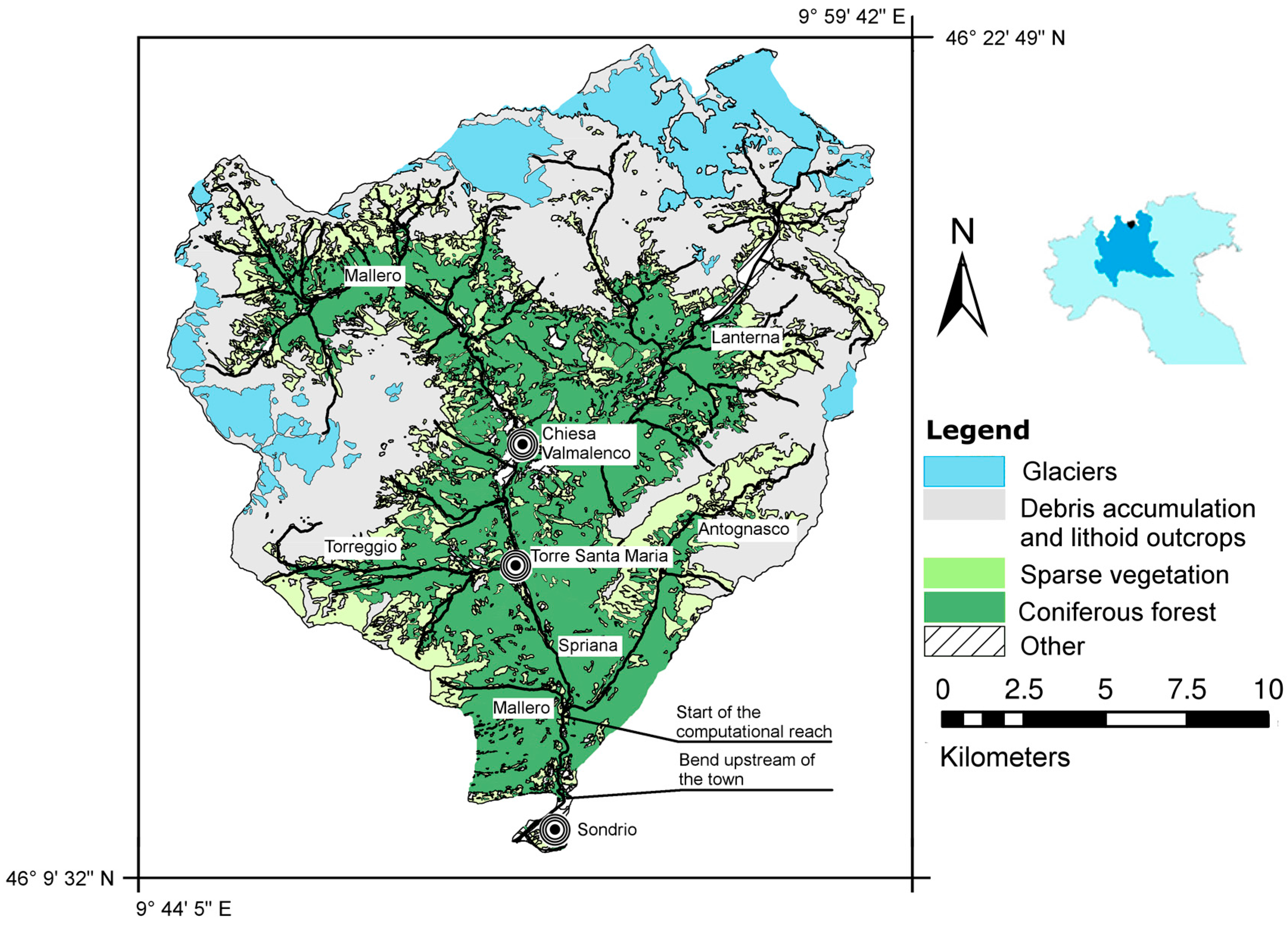
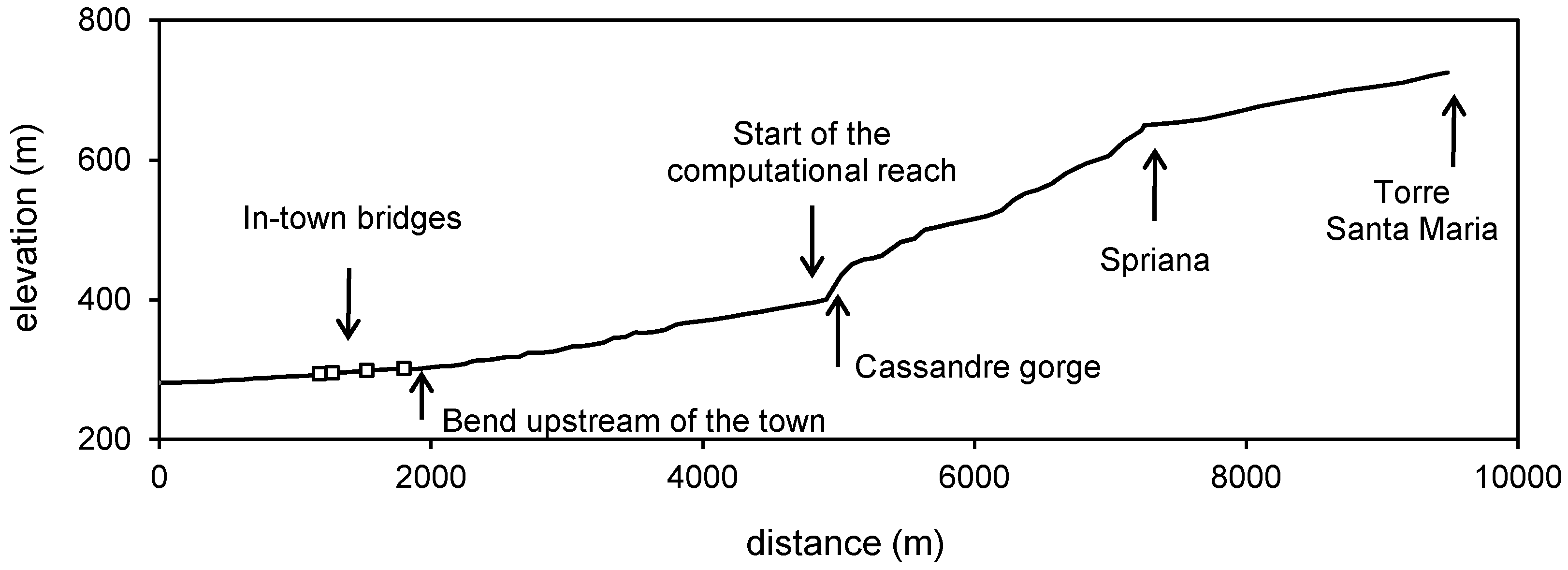
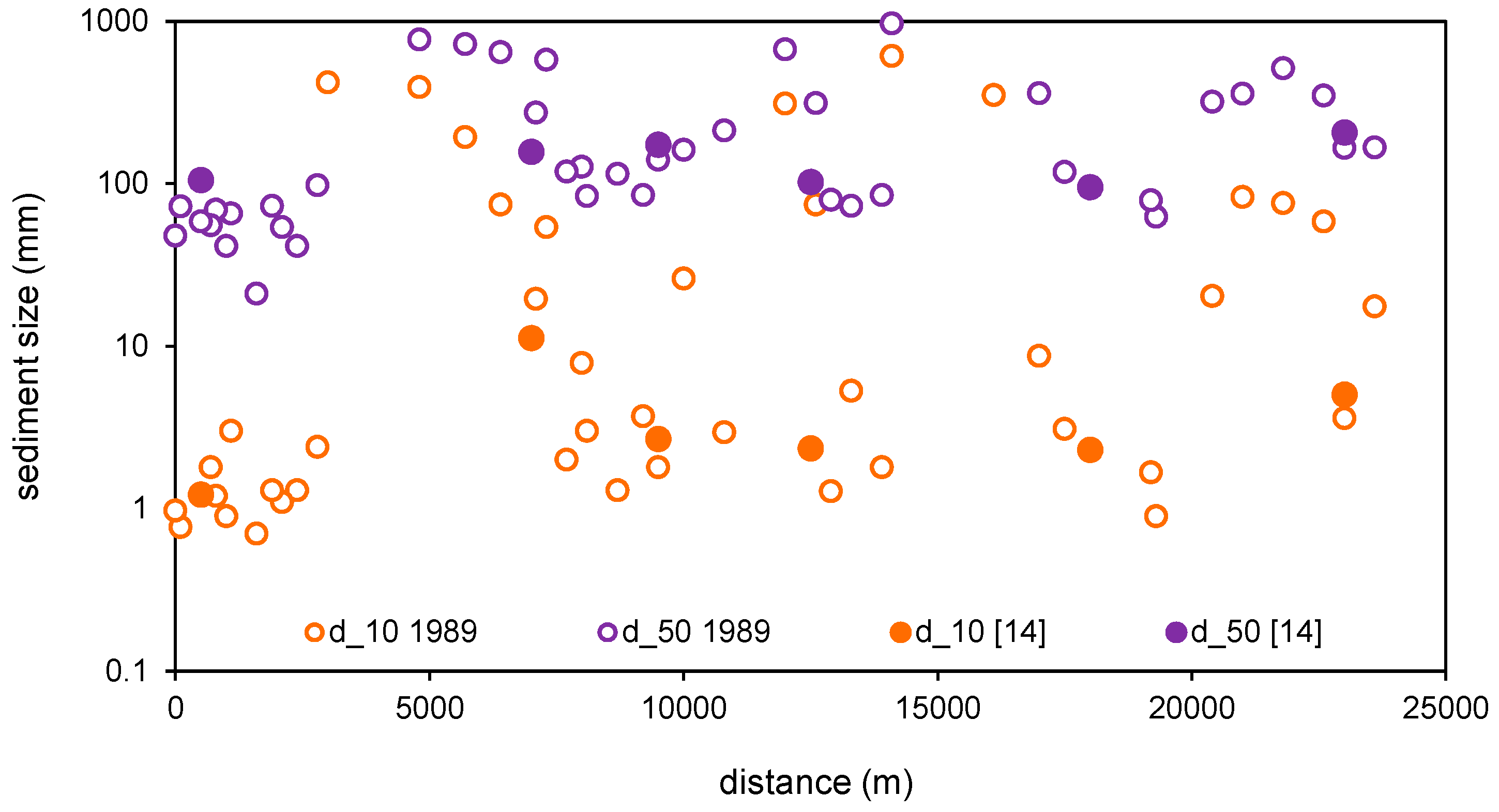
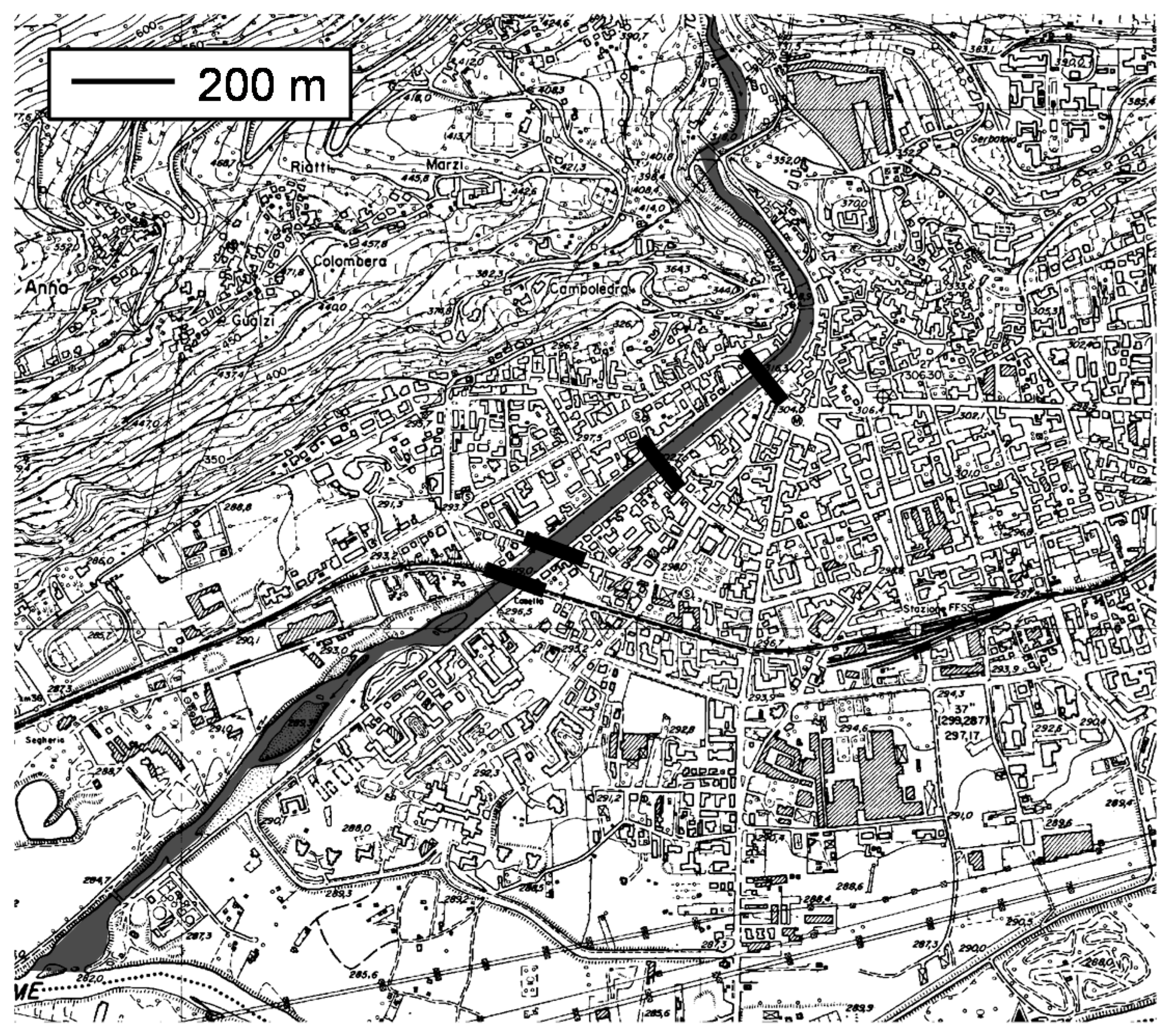
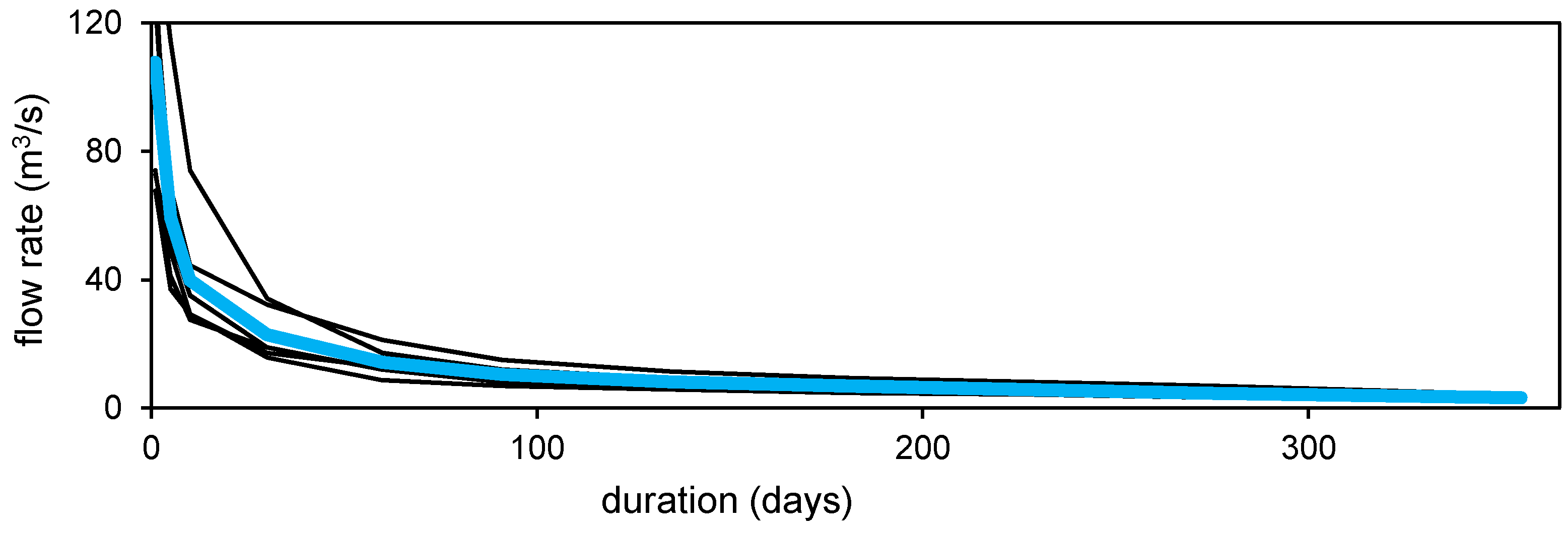

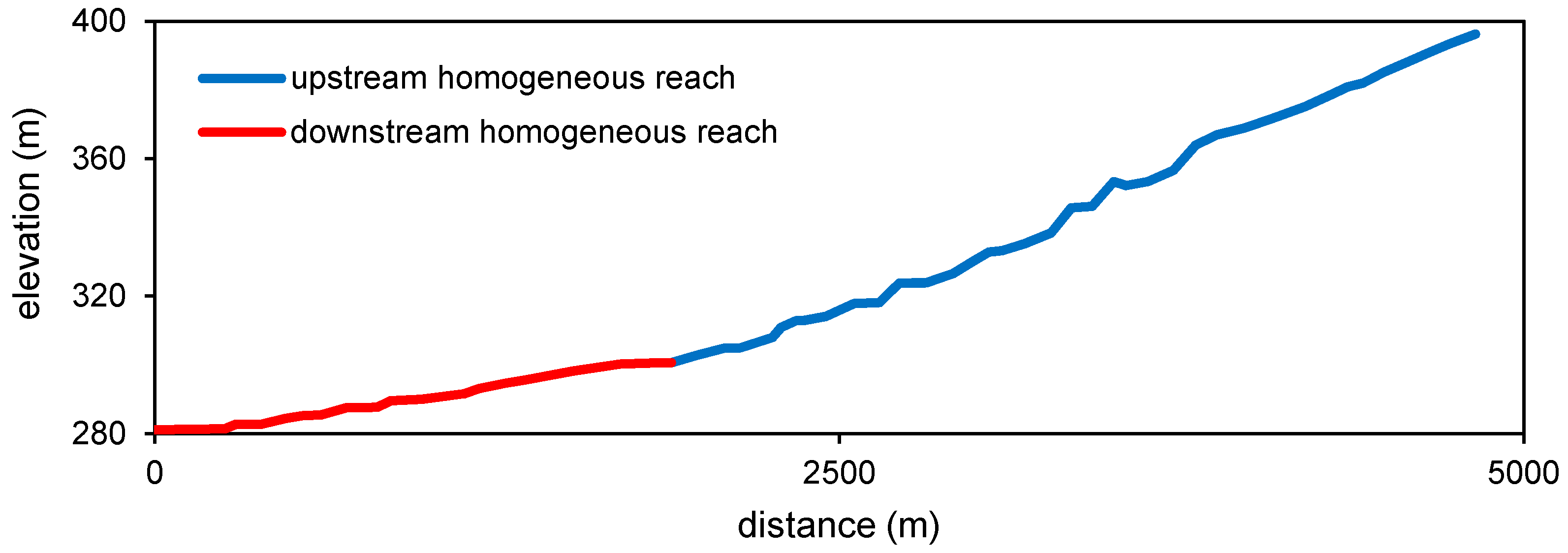
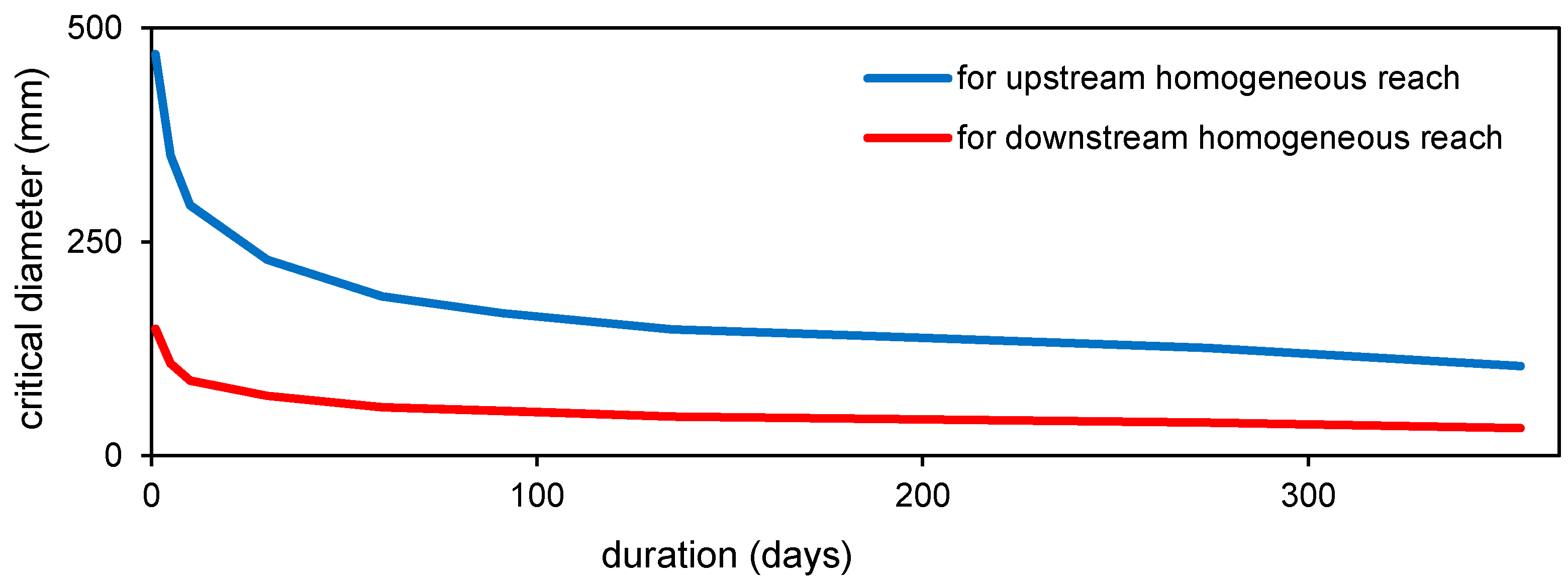
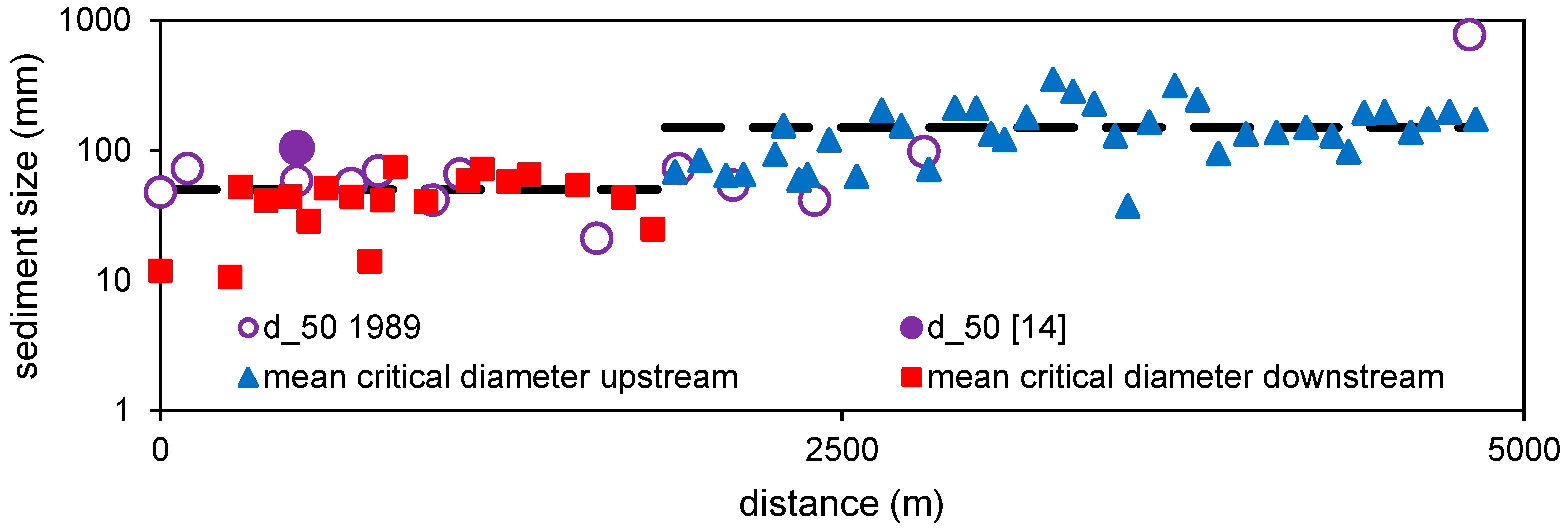
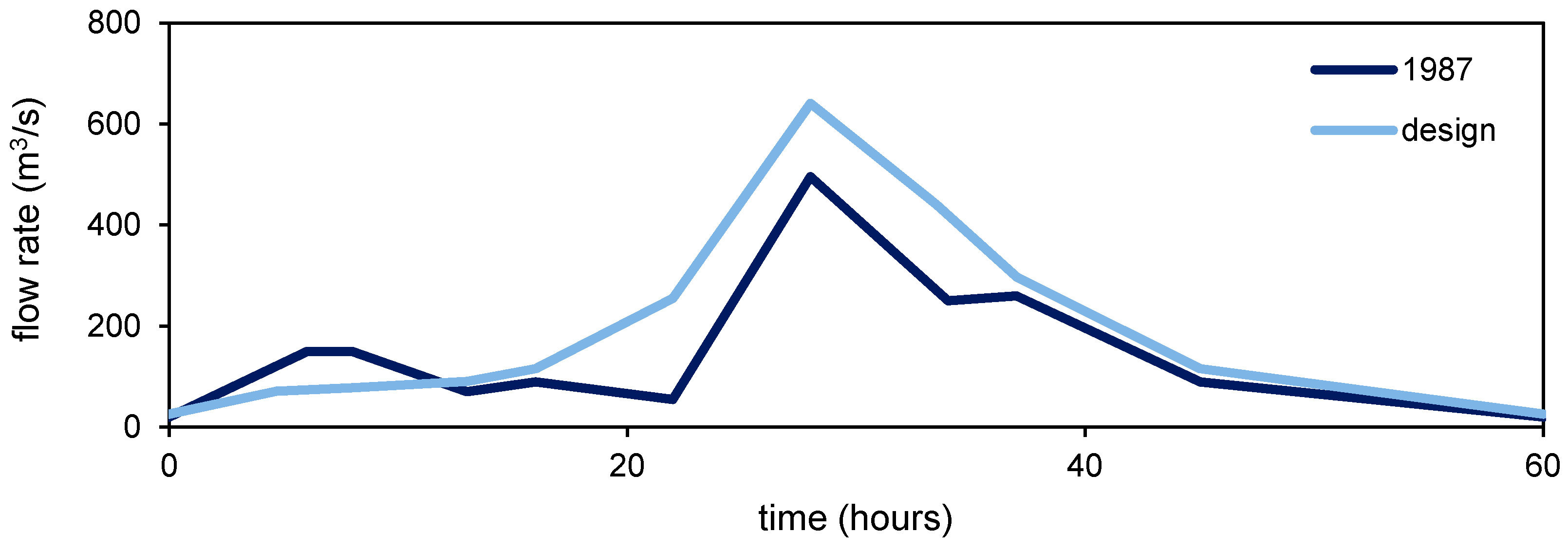
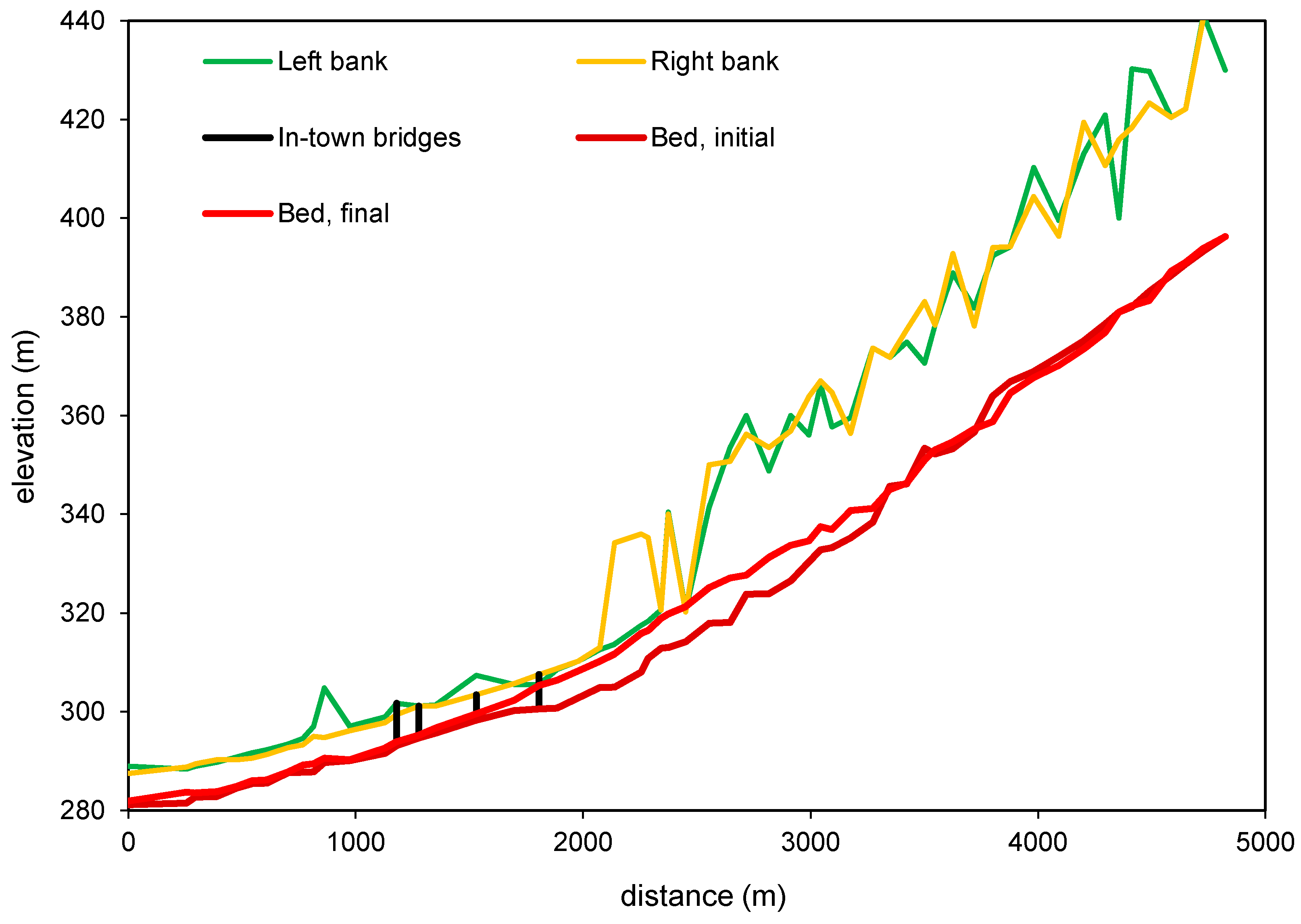
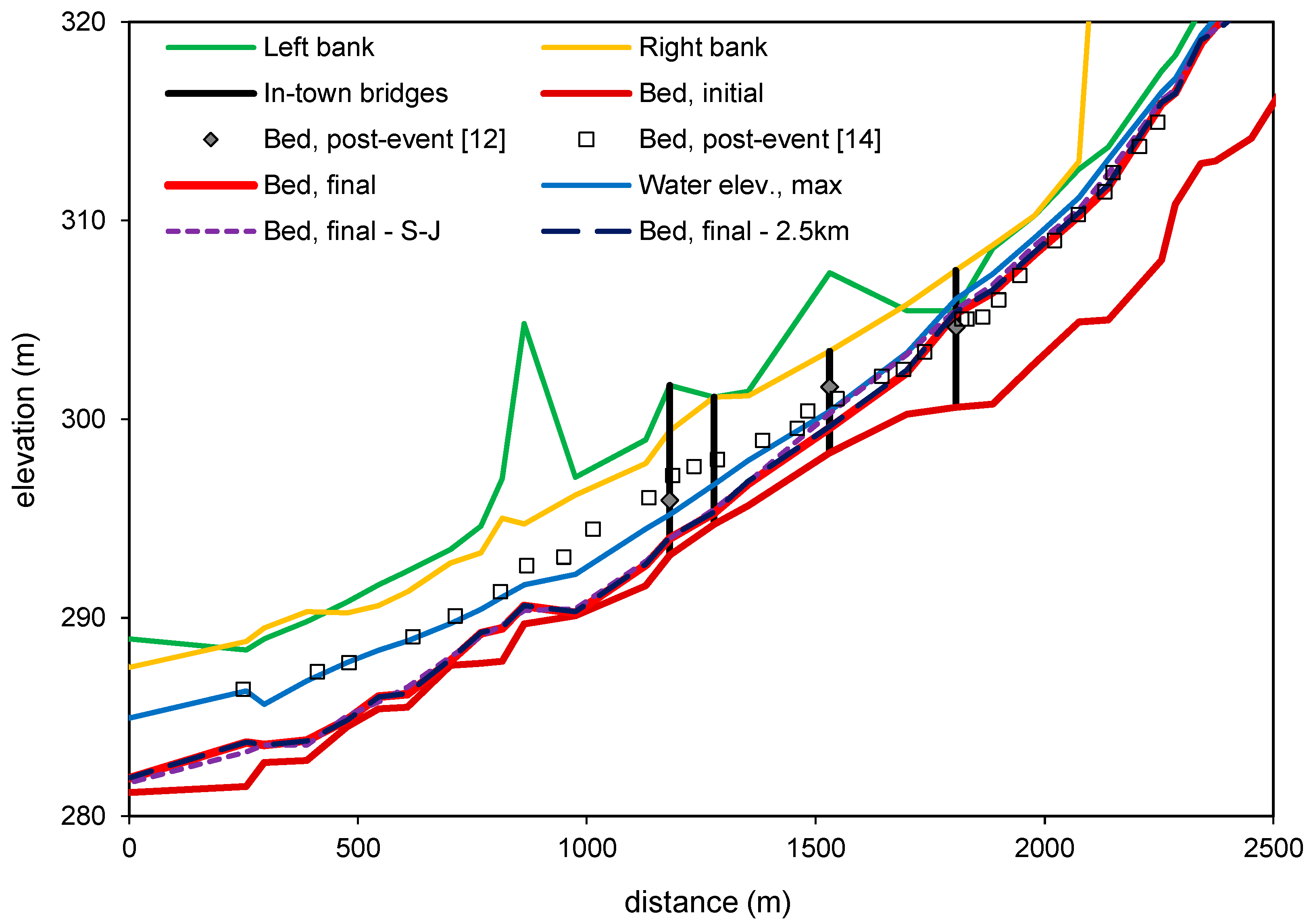


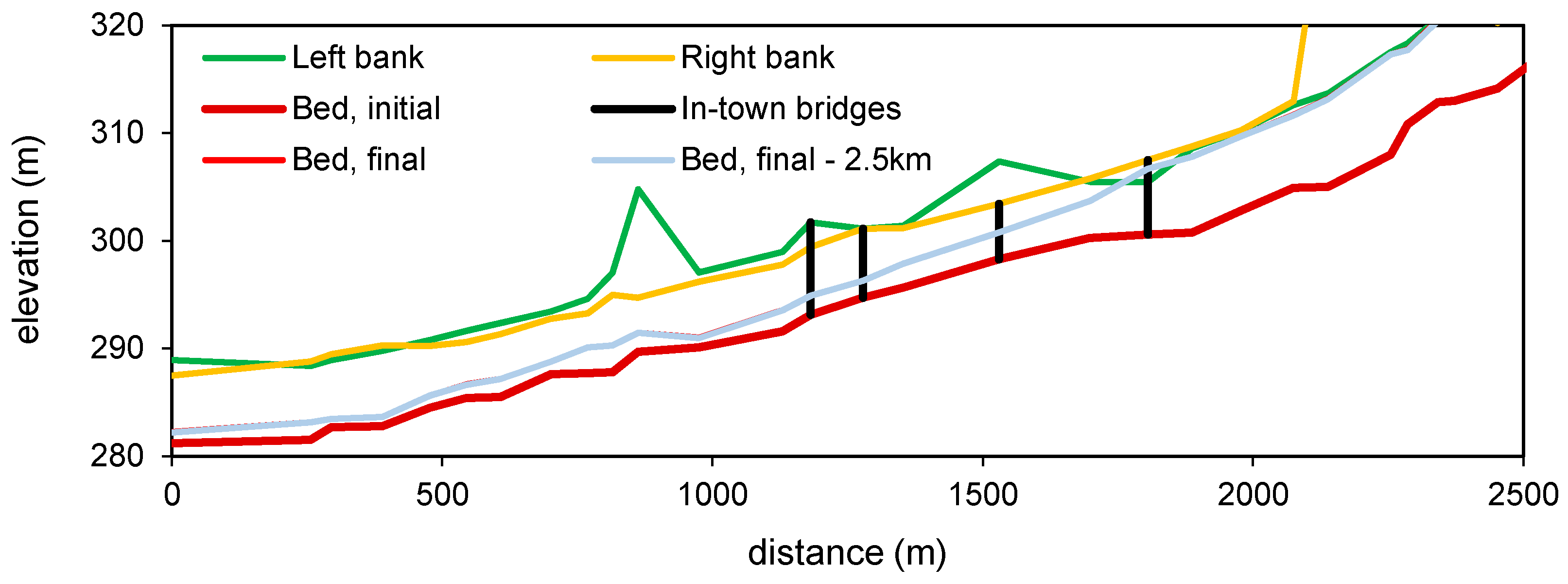
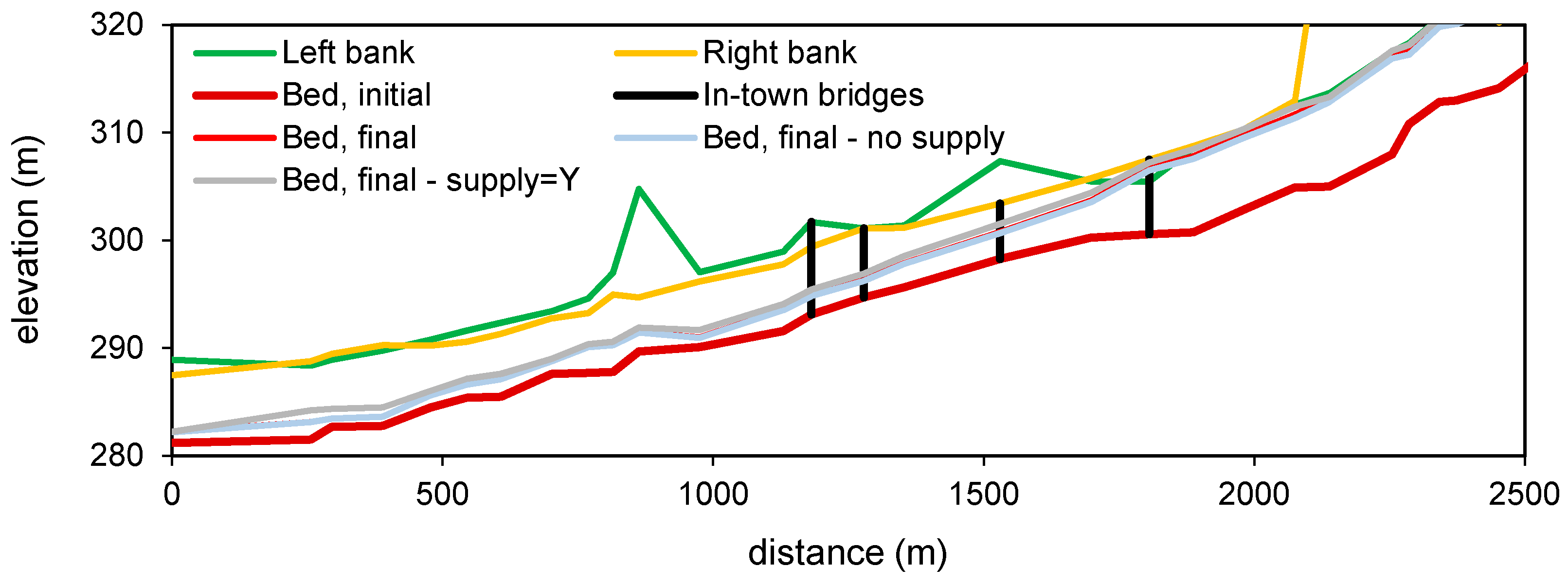
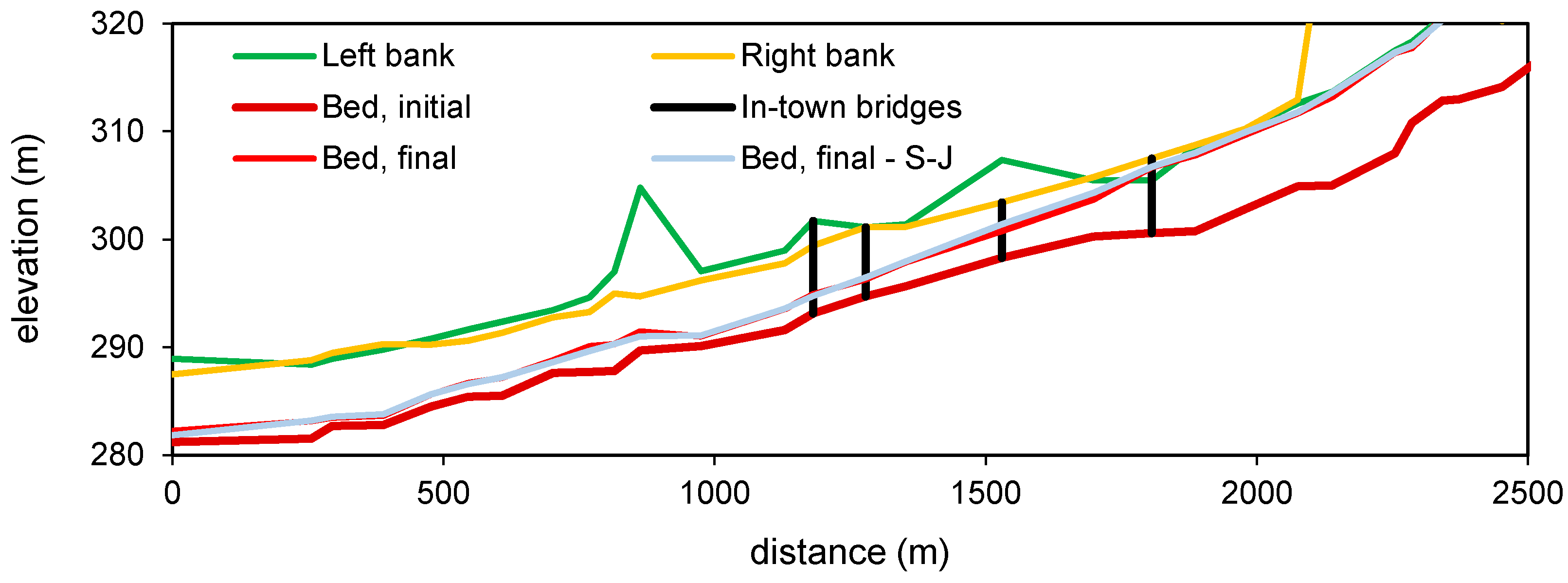
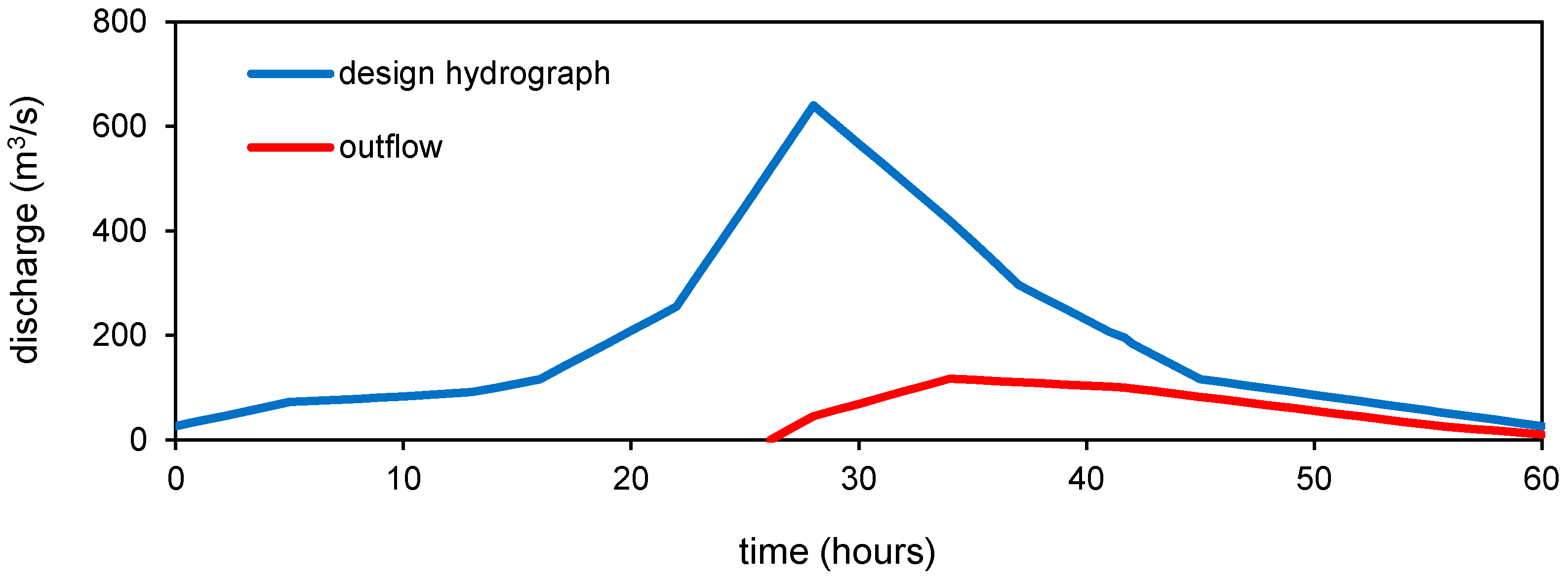
| Flow Rate (m3/s) | 108 | 59 | 40 | 23 | 14 | 11 | 8 | 7 | 5 | 3 |
| Duration (Days) | 1 | 5 | 10 | 30 | 60 | 91 | 135 | 182 | 274 | 355 |
© 2016 by the authors; licensee MDPI, Basel, Switzerland. This article is an open access article distributed under the terms and conditions of the Creative Commons Attribution (CC-BY) license (http://creativecommons.org/licenses/by/4.0/).
Share and Cite
Radice, A.; Longoni, L.; Papini, M.; Brambilla, D.; Ivanov, V.I. Generation of a Design Flood-Event Scenario for a Mountain River with Intense Sediment Transport. Water 2016, 8, 597. https://doi.org/10.3390/w8120597
Radice A, Longoni L, Papini M, Brambilla D, Ivanov VI. Generation of a Design Flood-Event Scenario for a Mountain River with Intense Sediment Transport. Water. 2016; 8(12):597. https://doi.org/10.3390/w8120597
Chicago/Turabian StyleRadice, Alessio, Laura Longoni, Monica Papini, Davide Brambilla, and Vladislav Ivov Ivanov. 2016. "Generation of a Design Flood-Event Scenario for a Mountain River with Intense Sediment Transport" Water 8, no. 12: 597. https://doi.org/10.3390/w8120597






